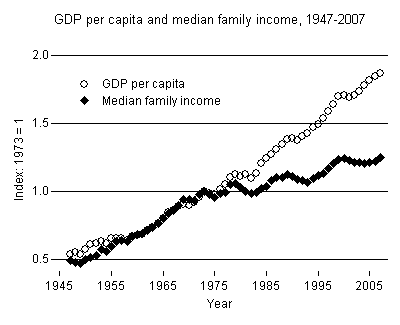State of the Union, Part 2—The Great Recession is far worse than any other post-war recession, and there are big underlying long-term problems.
 Friday, January 29, 2010 at 10:05AM
Friday, January 29, 2010 at 10:05AM In Part 1, I pointed to the disconnect between the President's vivid and dystopian description or our economic problems and his timid proposals to fix them. Here I quote from his State of the Union address and then post some charts and graphs to show that he does not overstate our problems. In Part 3, I'll post a list of Obama's proposals.
"One year ago, I took office amid two wars, an economy rocked by a severe recession, a financial system on the verge of collapse, and a government deeply in debt. Experts from across the political spectrum warned that if we did not act we might face a second depression. So we acted—immediately and aggressively. And one year later, the worst of the storm has passed.
"But the devastation remains. One in 10 Americans still cannot find work. Many businesses have shuttered. Home values have declined. Small towns and rural communities have been hit especially hard. And for those who'd already known poverty, life has become that much harder.
"The recession also compounded the burdens that America's families have been dealing with for decades—the burden of working harder and longer for less; of being unable to save enough to retire or help kids with college.
. . . .
"So we face big and difficult challenges."
. . . .
"We can't afford another so-called economic "expansion" like the one from the last decade—what some call the "lost decade"—where jobs grew more slowly than during any prior expansion; where the income of the average American household declined while the cost of health care and tuition reached record highs; where prosperity was build on a housing bubble and financial speculation."
. . . .
You see, Washington has been telling us to wait for decades, even as the problems have grown worse. Meanwhile, China is not waiting to revamp its economy. Germany is not waiting. India is not waiting. These nations—they're not standing still. These nations are playing for second place. They're putting more emphasis on math and science. They're rebuilding infrastructure. They're making serious investments in clean energy because they want those jobs. Well, I do not accept second place for the United States of America.
Obama is certainly correct that the unemployment problem has no post-WWII precedent, according to these charts from A Historical Look at Labor Markets During Recessions, by staff of the Federal Reserve Bank of Dallas. The unemployment rate has risen faster than in any other post-WWII recession and is well above the worst of those recessions, which was 1973.

Total civilian employment has declined more deeply and continued longer than in any other post-WWII recession.

Only in the Great Recession and in the recession of 2001 has the civilian labor force, which tends to grow with population growth, actually shrunk—this is caused by people staying in school, going back to school, or simply abandoning efforts to find work (in which case they are not counted as being in the labor force or "unemployed").

And here is Catherine Rampell on NYT's Economix blog showing the inexorable upward trend in the proportion of job losses that are permanently lost, not just temporary layoffs. In the Great Recession, for the first time ever, over half of the jobs shed are gone forever. How will those be replaced?

Obama is also correct that American families have been working longer and earning less for decades. Inflation-adjusted wages for the 5/6 of American workers who are not bosses are below where they were in 1973.

Inflation-adjusted average weekly earnings show a similar pattern, with August 2009 on the rise but still below the 1960s and 1970s, according to this LAT story.




Reader Comments (2)
Recession is still there but one should consider the post recession problems like austerity policies and the absence of investment has led to a situation that while most economies are now growing slowly, this has not led to an increase in employment.Growing rift between nations as the economic weight has been shifted from west to east,insufficient restructuring of developed countries to create the conditions for growth,etc etc.
Very, very nicely done! xaulgn xaulgn - Jimmy Choo Chaussures.